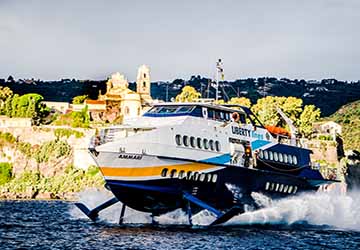
-
Recent Searches
Recent Searches
- Travel Alerts
- My Account
- Customer Service
-
United Kingdom
Salina to Filicudi Ferry
The Salina Filicudi ferry route connects Aeolian Islands with Aeolian Islands. Currently there is just the 1 ferry company operating this ferry service, Liberty Lines Fast Ferries. The crossing operates up to 21 times each week with sailing durations from around 40 minutes.
Salina Filicudi sailing durations and frequency may vary from season to season so we’d advise doing a live check to get the most up to date information.
Average Salina Filicudi Prices
Prices shown represent the average one way price paid by our customers. The most common booking on the Salina Filicudi route is a car and 1 passenger.
Salina Guide
Forming one of the Aeolian group of islands, Salina lies just to the north of Sicily and is the second largest island in the archipelago. The island is divided into three distinct areas. Santa Marina which is on the eastern coast, Malfi in the north and Leni in the south west. With a history that can be traced back to the 4th century, Salina began as a Greek settlement which at the time was called Didyme, which is a Greek name that means "twins" in reference to the two mountains on the island. However, the island was inhabited as far back as the Bronze Age and since then has been developed and abandoned many times. The island is popular with visitors and one of the most popular sights is the salt lake at Lingua which was once the site for the production of sea salt, hence the name Salina ("salt mill" in Italian). Also popular attractions are the Roman tombs that are located on the slopes of Fossa and the Sanctuary of the Madonna del Terzito, located between Malfi and Leni. This is the religious centre of the island and attracts many pilgrims on the main feast day of July 23rd each year.
Salina has two ports, Santa Marina and Rinella, served by ferries and hydrofoils from Hydrofoil service is active from Naples, Palermo, Reggio Calabria, Messina and Milazzo.
Filicudi Guide
The Italian island of Filicudi is one of the Aeolian Islands and lies off the north east coast of Sicily and is popular with scuba divers. A large part of the volcanic island is now designated as the "Natural Reserve of Filicudi Island". The island is made up of several layers of lava with oldest being located in the sea in front of 'Fil di Sciacca' with the largest being 'Fossa delle felci' and the most recent being 'Montagnola'. The island's slopes tend to be steep and rocky with houses located around the "Porto Pecorini" and "Valdichiesa" where the Church of St. Stephen, the island's patron saint, can be found.
To the north of the island is the spectacular “Punta Zucco Grande” (with ten layers of lava) with the eastern side of the island being a less harsh environment. Perhaps the most beautiful landscapes on the island are the “Punta Perciato” and the giant boulders of the “Rupi delle Sciare” ["Cliffs of the ‘Sciara’”], which are steep vertical cliffs overlooking the sea.


